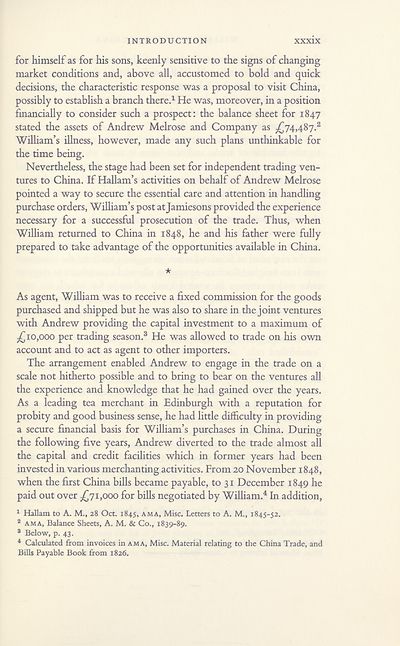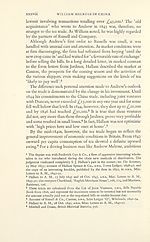Series 4 > William Melrose in China, 1845-1855
(44) Page xxxix
Download files
Complete book:
Individual page:
Thumbnail gallery: Grid view | List view

INTRODUCTION
xxxix
for himself as for his sons, keenly sensitive to the signs of changing
market conditions and, above all, accustomed to bold and quick
decisions, the characteristic response was a proposal to visit China,
possibly to establish a branch there.1 He was, moreover, in a position
financially to consider such a prospect: the balance sheet for 1847
stated the assets of Andrew Melrose and Company as ^74,487.2
William’s illness, however, made any such plans unthinkable for
the time being.
Nevertheless, the stage had been set for independent trading ven¬
tures to China. If Hallam’s activities on behalf of Andrew Melrose
pointed a way to secure the essential care and attention in handling
purchase orders, William’s post at Jamiesons provided the experience
necessary for a successful prosecution of the trade. Thus, when
William returned to China in 1848, he and his father were fully
prepared to take advantage of the opportunities available in China.
As agent, William was to receive a fixed commission for the goods
purchased and shipped but he was also to share in the joint ventures
with Andrew providing the capital investment to a maximum of
.£10,000 per trading season.3 He was allowed to trade on his own
account and to act as agent to other importers.
The arrangement enabled Andrew to engage in the trade on a
scale not hitherto possible and to bring to bear on the ventures all
the experience and knowledge that he had gained over the years.
As a leading tea merchant in Edinburgh with a reputation for
probity and good business sense, he had little difficulty in providing
a secure financial basis for William’s purchases in China. During
the following five years, Andrew diverted to the trade almost all
the capital and credit facilities which in former years had been
invested in various merchanting activities. From 20 November 1848,
when the first China bills became payable, to 31 December 1849 he
paid out over £71,000 for bills negotiated by William.4 In addition,
1 Hallam to A. M., 28 Oct. 1845, ama, Misc. Letters to A. M., 1845-52.
2 ama, Balance Sheets, A. M. & Co., 1839-89.
8 Below, p. 43.
4 Calculated from invoices in ama, Misc. Material relating to the China Trade, and
Bills Payable Book from 1826.
xxxix
for himself as for his sons, keenly sensitive to the signs of changing
market conditions and, above all, accustomed to bold and quick
decisions, the characteristic response was a proposal to visit China,
possibly to establish a branch there.1 He was, moreover, in a position
financially to consider such a prospect: the balance sheet for 1847
stated the assets of Andrew Melrose and Company as ^74,487.2
William’s illness, however, made any such plans unthinkable for
the time being.
Nevertheless, the stage had been set for independent trading ven¬
tures to China. If Hallam’s activities on behalf of Andrew Melrose
pointed a way to secure the essential care and attention in handling
purchase orders, William’s post at Jamiesons provided the experience
necessary for a successful prosecution of the trade. Thus, when
William returned to China in 1848, he and his father were fully
prepared to take advantage of the opportunities available in China.
As agent, William was to receive a fixed commission for the goods
purchased and shipped but he was also to share in the joint ventures
with Andrew providing the capital investment to a maximum of
.£10,000 per trading season.3 He was allowed to trade on his own
account and to act as agent to other importers.
The arrangement enabled Andrew to engage in the trade on a
scale not hitherto possible and to bring to bear on the ventures all
the experience and knowledge that he had gained over the years.
As a leading tea merchant in Edinburgh with a reputation for
probity and good business sense, he had little difficulty in providing
a secure financial basis for William’s purchases in China. During
the following five years, Andrew diverted to the trade almost all
the capital and credit facilities which in former years had been
invested in various merchanting activities. From 20 November 1848,
when the first China bills became payable, to 31 December 1849 he
paid out over £71,000 for bills negotiated by William.4 In addition,
1 Hallam to A. M., 28 Oct. 1845, ama, Misc. Letters to A. M., 1845-52.
2 ama, Balance Sheets, A. M. & Co., 1839-89.
8 Below, p. 43.
4 Calculated from invoices in ama, Misc. Material relating to the China Trade, and
Bills Payable Book from 1826.
Set display mode to:
![]() Universal Viewer |
Universal Viewer | ![]() Mirador |
Large image | Transcription
Mirador |
Large image | Transcription
Images and transcriptions on this page, including medium image downloads, may be used under the Creative Commons Attribution 4.0 International Licence unless otherwise stated. ![]()
| Scottish History Society volumes > Series 4 > William Melrose in China, 1845-1855 > (44) Page xxxix |
|---|
| Permanent URL | https://digital.nls.uk/127695105 |
|---|
| Description | Over 180 volumes, published by the Scottish History Society, containing original sources on Scotland's history and people. With a wide range of subjects, the books collectively cover all periods from the 12th to 20th centuries, and reflect changing trends in Scottish history. Sources are accompanied by scholarly interpretation, references and bibliographies. Volumes are usually published annually, and more digitised volumes will be added as they become available. |
|---|


